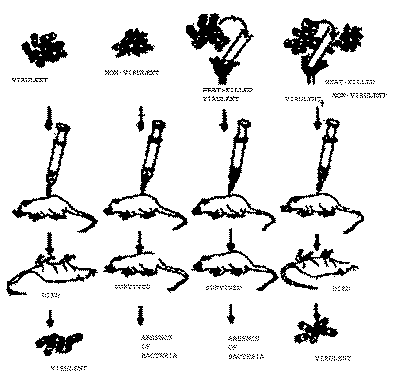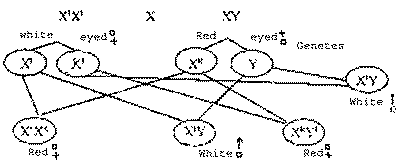|
CBSE ANNUAL PAPER - 1999
BIOLOGY
(SET-I)
Time Allowed : 3 Hours
Max. Marks : 70
General
Instructions :
(i) All
questions are compulsory.
(ii) Marks for each
question are indicated against
it.
(iii) Q. Nos. 1-11 are very
short answer type carrying one mark each only.
Answer them in one word one sentence.
(iv) Q. Nos. 12-23 are
short answer questions carrying 2 marks each. It
is appropriate to answer them in about 30-50
words.
(v) Q. Nos. 24-28 are short
answer questions carrying 3 marks each. It is
appropriate to answer them in about 30-50
words,.
(vi) Q. Nos. 29-32 are long
answer questions carrying 5 marks each. It is
appropriate to answer them in about 40-100
words.
(viii) Do not unnecessarily
make the answer lengthier than desired.
|
|
Section - A
Q. Nos. 1-8
are of very short 1-20 words each.
|
| Q.1. |
Name the process in which are
bacteriophage picks up a piece of DNA from one
bacterial cell and transfer the same to another
bacterial cell on infection.
|
| Ans. |
Transduction.
|
| Q.2. |
Which fraction of soil H2O is readily available to plants
for absorption ?
|
| Ans. |
Capillary H2O .
|
| Q.3. |
What protects nitrogenase ?
|
| Ans. |
Leg hemoglobin.
|
| Q.4. |
Name two plants that produce rhizomes.
|
| Ans. |
Ginger,
Banana. |
| Q.5. |
Why is oxytocin called as 'birth harmone'?
|
| Ans. |
It helps uterine
contraction. |
| Q.6. |
From which germ layers do the following
organs differentiate. (i) Kidney
(ii) Urinary
bladder. |
| Ans. |
(i) Kidney - Mesoderm
(ii) Urinary bladder -
Mesoderm. |
| Q.7. |
What provided energy for abiotic synthesis
on the primitive earth ?
|
| Ans. |
Legthening and UV
radiations. |
| Q.8. |
Name the two curable sexually transmitted
disease.
|
| Ans. |
Syphilis, gonorrhea.
|
|
Section - B
Q. Nos. 9-18
.....20-30 words
each. |
| Q.9. |
In
most plants the terminal bud suppresses the
development of lateral buds. What is this
phenomenon called. Name the phytohormone that
can promote the phenomenon.
|
| Ans.
|
Apical Dominance. PR Promotes this
phenomenon. |
| Q.10. |
Sieve tubes in angiousperms are associated
with specialised paprenchyma cells. Name those
cells. How do they help sieve tube members ?
|
| Ans. |
Companion cells. They help
in physiological functioning of sieve
tubes. |
| Q.11. |
How is the digested fat absorbed ?
|
| Ans.
|
Digested fats are covered
with water molecules to form micelles. They are
absorbed in this form and is transported as
chylomicrons. |
| Q.12. |
What are antagonistic muscles ?
|
| Ans. |
Muscles that work in
opposite directions but from same plane are
antagonistic muscles. For e.g. Flexor and
extensor.
|
| Q.13. |
Describe the methods of
birth control by which fertilization of Ovum by
sperm is prevented.
|
| Ans. |
The method is IUCD. In this
method Copper - T or Loop is inserted in the
uterus of female so that fertilization does not
take place.
|
| Q.14. |
What is artificial selection in terms of
evolution ? Name one plant that has been
produced as a result of artificial selection.
|
| Ans. |
It is a process in which
hybridisation occurs between two organisms of
desired characters. In plants cabbage,
cauliflower and caulrabi are obtained from
clueucort. |
| Q.15. |
'Birds have evolved from reptiles'. How
does palaentology provide evidence in support of
the above statement ?
|
| Ans. |
With the help of
'Archaeopteryx' we are able to find that birds
have evolved from reptiles because it has beak
with teeth, wings with claws and tail with
vertebral column. |
| Q.16. |
Who discovered the co-acervetes? List the
biological properties of co-acervates.
|
| Ans. |
Oparin
Haldane (i) They are self-duplicating.
(ii) They are Chemoheterotrophs.
|
| Q.17. |
What is mycorrhiza? How does it act as
biofertilizis? |
| Ans. |
Mycorrhiza is a symbiotic
association between fungus and roots of higher
plants. It act as biofertilizer as its hyphae
moves to the soil depth and bring minerals for
the plants. They also store various minerals in
their mantle. |
| Q.18. |
Define autommune diseases. Give two
examples. |
| Ans. |
When the body immune
system, turns against its own body the diseases
are auto immune diseases. For eg - AIDS, Chronic
anemia.
|
|
Section -
C
Q. Nos. 30-50
words each.
|
| Q.19. |
What is transformation? Describe
Griffith's transformation experiment.
|
| Ans. |
In 1928, an English
bacteriologist, Fredrick. Griffith conducted
experiments with the bacterium that causes
pneumonia, Diplococus pneumonia. There are two
main types of this bacteria, smooth (S) and
routh (R). S-type cells have a capsule around
capsule, are virulent and cause pneumonia. The
R-type bacteria do not have the capsule and are
avirulent and harmless. The S-type bacteria when
injected into mice cuase pneumonia and
subsequent death of the animal whereas the
R-type bacteria when injected into mice are
found to be harmless. Griffith found that the
s-type bacteria when killed by heat prior to
injection into mice did not cause the disease.
However, when heat killed S-type bacteria were
injected into mice along with a virulent, R-type
bacteria, mice suffered from pneumonia and died.
Examination of the dead mice revealed that death
occurrred due to the living S-type bacteria.
Griffith concluded from this experiment that the
a virulent R-type bacteria bacteria had been
transformed into S-type, capsule variety. In
other words, the dead S-type bacteria had
transmitted their virulence to the living R-type
a virulent bacteria. This experiment showed that
some component of the bacterial cell is
responsible for the phenomenon of
transformation.

|
| Q.20. |
What are linked genes ? Diagrammatically
represent a cross between a white eyed female
and red eyed male Drosphilia.
|
| Ans. |
When genes are very closely
present on the chromosomes so that they cannot
be separated. They are called linked genes.

|
| Q.21. |
How does an excess of tryptophen cause
"SWITCHING OFF" of the tryptophan
Operon ? |
| Ans. |
When tryptophan is produced
in excess it combines with repressor molecule to
form co-repressor. This then kinds to the
operator. The Switch of operator is off. It can
no longer give order to structural genes and
structural genes slopes the synthesis of
tryptophane in the medium.
|
| Q.22. |
If
biotic origin of life is in progress on a planet
other than earth, what should be the conditions
there ? Explain.
|
| Ans. |
(1) Presence of gases like
CH4, NH3 water vapours.
(2) Reducing atmosphere.
(3) High temp.
(4) Energy supply by UV radiations.
|
| Q.23. |
Trace the formation of Ovum from ogonium.
|
| Ans. |
Oogenesis occurs in ovary.
It is a process of formation of ova in the
ovary. During this process egg mother cells
produce oogania (2n). Oognia develops into
primary oocytes. these primary oocyte under
gomeiotic division as a result of which one
functional OVA and three polar bodies are
produced. Later on three small polar bodies
disappears. Thus only one ocyte is functional.
It is non motile, large sized ovum.
|
| Q.24. |
Describe the robe of red blood cells in
the transport of oxygen and carbon dioxide by
blood. |
| Ans. |
(i) Oxygen get attached to
hemoglobin to form oxyhemoglobin and is
transported in this form in the blood.
(ii) The three forms in
which
CO2
is carried by blood in human body are :
(a) As bicarbonates of Na and K ( about 85
% of CO2
is carried in this form).
(b) As carbiminohemoglobin With Hb ( 10 %
of CO2).
(c) As carbonic acid in plasma ( 0.5 % of
CO2).
(iii) Carbonic anhydrase.
|
| Q.25. |
Draw a diagram to show the cultural
structure of human heart. Label six parts in all
including at least three values.
|
| Ans. |

|
| Q.26. |
What is metastasis ? List any four danger
signals of
cancer. |
| Ans. |
The movement of cancerous
cells to distant places is called metastasis.
Danger signals of cancer :
(1) Any persistent lump in breast / tongue
or lips.
(2) Any wound that does not heal up
easily.
(3) Unusual bleeding from any part of the
body.
(4) A rapid change in wart or mole.
(5) Change in bowel in wart of mole.
(6) Hoarseness in voice.
|
| Q.27. |
What is meant by biotic synthesis ? Who
proposed this idea and who supported it
experimentally. |
| Ans.
|
In the beginning, the earth
was very hot & everything was in gaseous
form. Gradually, cooling took place. Life
originated about 4600-3600 million years ago.
Cyanobacteria like organism appeared first. The
earth's atmosphere at that time was reducing.
When complex molecules were formed from simple
molecules present in the earth's primordial
soup. The energy for these reactions came from
heat, Cosmic rays and lightning. (Oparin -
Haldane theory) Experimentally Urey & Miller
supported the theory given by oparin Haldane.
|
| Q.28. |
Describe the process of DNA replication.
|
| Ans. |
1. Unwinding of interwinded
DNA at several points by the action of enzyme
helicase and topoisometrase. 2. unwinding of the strand
give the DNA a Y shaped
structure.
3. DNA polymerase start
synthesizing new strand of DNA in 5 -- 3'
direction this is known as leading strand.
4. It opposite direction it
synthesize DNA fragment in 5'--x' these are
called okazaki fragments.
5. These fragments are then
joined together by the action of the enzyme
ligase to complete the replication process.
|
| Q.29. |
Specify how C4 photosythetic pathway increases
CO2
concentration in bundle sheath cells of
sugarcane. How much is C4 pathway more energy expensive than
C3 pathway.
|
| Ans. |
The anatomy of leaves of
C4 plants is
different from leaves of C3 plants. This type of anotomy is
called Kranz anatomy. In the leaves of such
plants. Palisade tssue is absent. There is a
bundle sheath around the vascular bundles. The
chloroplasts in the bundle sheath cells present
are large and without or less developed groove
whereas in the mesophyll cells the chloroplasts
are small but with well developed groove.
CO2taken from atmosphere is accepted
by 3 carbon compound. Pyruvate in the
chloroplasts of mesophy II cells leading to the
formation of 4-C compound the malic acid. It is
transported to the Chloroplasts of bundle sheath
cells. Here malic acid (C4) is converted to Pyruvic acid
(C3) with the
release of CO2 .
Thus concentration of CO2 increase in the hundle sheath
cells. These cells contain enzymes of calvin
cycle. because of high concentration of CO2 RuBP Carboxylase
participate in calvin cycle is transported into
the phloem.
Pyruvic acid generated in
the bundle sheath cells re-enters mesophyll
cells and regenerates phosphoenol pyruvic acid
by consuming one ATP. Since the conversion
results in the formation of AMP ( not ADP),
needs 12 glucose molecule, whereas C4 Pathway requires 30
ATP.

|
| Q.30. |
What is a synapse ? How is the nerve
impulse transmitted across a synapse ?
|
| Ans. |
Synapse is the junction
between two neutrons where one axon gives the
information to another through dendrites.
Synapse is formed when the two meeting
dendrictes looses its myelin sheath to form
synaptic knob. this synaptic knobs are separated
by synaptic claft filled with synaptic fluid.
Messages are present within the synaptic knob in
the form of chemicals like adrenaline or a
acetylcholine. These chemicals are confined with
in the synaptic vesicles . the vesicles carrying
the chemicals moves from the donor dentrite to
the recepient dendrite through synaptic fluid.
Thus there is movement of messages from one
neuron to another.

|





